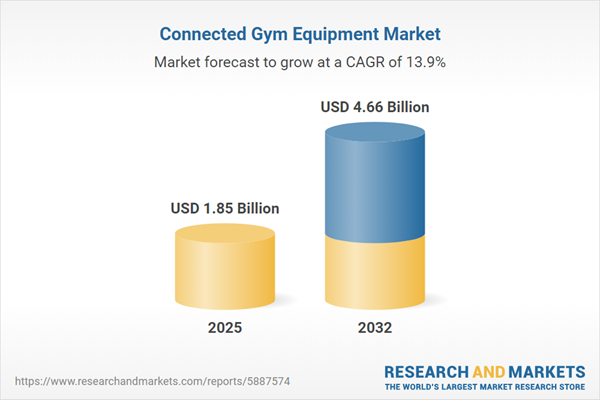Speak directly to the analyst to clarify any post sales queries you may have.
The connected gym equipment market is reshaping the way fitness operators approach business agility, digital engagement, and operational resilience. As organizations shift toward digitally integrated environments, senior leaders are navigating new opportunities for scalable efficiency and sustained client impact.
Market Snapshot: Connected Gym Equipment Market Size and Growth
The connected gym equipment market achieved a value of USD 1.64 billion in 2024, with forecasted growth to USD 1.85 billion by 2025 and USD 4.66 billion by 2032. This reflects a compound annual growth rate (CAGR) of 13.93%. The upward trend is linked to enterprise adoption of comprehensive digital platforms and advanced fitness technology across both commercial and residential use cases. Investments are accelerating the deployment of intelligent gym equipment, facilitating technology-driven transformation for operators aiming for greater business continuity and competitive adaptation.
Scope & Segmentation: Strategic Framework in the Connected Gym Equipment Market
This report equips senior executives with granular insight for strategic planning and risk mitigation as digitalization transforms fitness service delivery. The segmentation framework below supports confident investment allocation, compliance alignment, and operational flexibility:
- Equipment Types: Includes cardio equipment like treadmills, ellipticals, bikes, and rowers, as well as strength-focused tools such as connected benches and digital resistance bands. These solutions enable facilities to restructure training zones to meet evolving program demands.
- Connectivity Modes: Integration with Wi-Fi, Bluetooth, NFC, and RFID technologies creates seamless connections between equipment and facility management platforms. This supports real-time data flow and enhances interoperability.
- End Users: Addresses gym chains, boutique fitness studios, hospitality and wellness venues, and the growing residential fitness segment. End users benefit from robust analytics, enhanced experiences, and agile operations.
- Distribution Channels: Spans specialty distributors, retail sports outlets, direct digital channels, and e-commerce, expanding reach and accelerating the adoption of digital fitness tools.
- Regions Covered: Analysis encompasses North America, Europe, Asia-Pacific, and the Middle East & Africa. Special focus is placed on China, India, and Japan, where consumer trends and local regulations guide regional strategies.
- Key Companies Analyzed: Major organizations include ConnectFit, EGYM, Nautilus, Precor, Christian’s Fitness Factory, Core Health & Fitness, Echelon Fitness, iFIT, Jerai Fitness, Johnson Health Tech, Life Fitness, Panatta S.p.A., Paradigm Health & Wellness, Peloton Interactive, TECHNOGYM, Tonal Systems, BFT Fitness, Les Mills International, Draper, Hydrow, myx Fitness, FightCamp by Hykso, Tempo Interactive, MIRROR, CLMBR, Blue Goji, Impulse Health Tech, EXERCYCLE, Interactive Strength, and Precor.
These segments provide a structured basis for prioritizing business model evolution, regional expansion, and technology partnerships aimed at maintaining operational adaptability and regulatory compliance.
Key Takeaways for Senior Leaders
- Digital fitness ecosystems support streamlined management across single and multi-site networks, helping ensure consistent service quality and improving organizational responsiveness.
- Centralizing member and device data empowers organizations to introduce new training options without disrupting existing services, underpinning market agility.
- Flexible connected equipment enables facilities to pivot quickly as consumer preferences change, sustaining engagement and supporting scalable growth.
- Advanced sensor integration and AI drive training personalization, higher user engagement, and measurable differentiation in a saturated provider landscape.
- Strategic alliances among manufacturers and technology firms are elevating privacy, compliance, and service delivery standards across evolving regional frameworks.
Tariff Impact on Supply Chains and Cost Structures
The recent introduction of United States tariffs is intensifying supply chain complexity for businesses in the connected gym equipment sector. In response, companies are relocating production facilities nearer key markets, expanding supplier networks, and refining procurement strategies. Streamlined processes and increased transparency are helping businesses control costs and ensure reliable sourcing, even as trade policies shift.
Methodology & Data Sources
This report combines insights from executive interviews, regulatory and technical document reviews, international patent analysis, and structured market research evaluation. The approach ensures balanced and reliable intelligence for both market trends and supply chain strategies within the connected gym equipment industry.
Why This Report Matters
- Delivers actionable recommendations for aligning organizational strategy with evolving digital fitness demands and growing compliance requirements.
- Provides frameworks for identifying supply chain risks and navigating successful regional market entry amid technological disruption.
- Supports informed investment in advanced digital technologies with guidance adapted to segment and regional specificities.
Conclusion
Connected gym equipment is changing how fitness businesses operate and compete. Organizations advancing digitalization and operational flexibility are better equipped for lasting success in today’s evolving marketplace.
Additional Product Information:
- Purchase of this report includes 1 year online access with quarterly updates.
- This report can be updated on request. Please contact our Customer Experience team using the Ask a Question widget on our website.
Table of Contents
3. Executive Summary
4. Market Overview
7. Cumulative Impact of Artificial Intelligence 2025
Companies Mentioned
The companies profiled in this Connected Gym Equipment market report include:- ConnectFit
- EGYM, Inc
- Nautilus, Inc
- Precor Inc
- Christian's Fitness Factory Inc
- Core Health & Fitness, LLC.
- Echelon Fitness, Inc.
- iFIT Inc.
- Jerai Fitness Pvt. Ltd.
- Johnson Health Tech Co., Ltd
- Life Fitness
- Panatta S.p.A.
- Paradigm Health & Wellness
- Peloton Interactive Inc.
- TECHNOGYM S.p.A
- Tonal Systems Inc.
- BFT Fitness
- Les Mills International Ltd.
- Draper, Inc.
- Hydrow, Inc.
- myx Fitness
- FightCamp by Hykso, Inc.
- Tempo Interactive Inc.
- MIRROR
- CLMBR, INC.
- Blue Goji LLC
- Impulse (QingDao) Health Tech CO., LTD
- EXERCYCLE S.L.
- Interactive Strength, Inc.
- Precor
Table Information
| Report Attribute | Details |
|---|---|
| No. of Pages | 199 |
| Published | November 2025 |
| Forecast Period | 2025 - 2032 |
| Estimated Market Value ( USD | $ 1.85 Billion |
| Forecasted Market Value ( USD | $ 4.66 Billion |
| Compound Annual Growth Rate | 13.9% |
| Regions Covered | Global |
| No. of Companies Mentioned | 31 |









